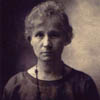Your shopping cart is empty!
Select currency
MENU

Nettie Blanche Lazzell was born on 10th October, 1878, on the 200 acre family farm near the Monongahela River in Maidsville, West Virginia, to Cornelius Carhart Lazzell (1828-1908) and Mary Prudence Pope (1841-1891). Nettie Blanche Lazzell attended a small one-room school before departing for Buckhannon where she enrolled in a seminary now know as West Virginia Wesleyan. She continued her studies at South Carolina Co-Educational Institute, and from 1901-05 she took courses at West Virginia University where she attained a Bachelor of Arts degree in fine arts.
In the autumn of 1907 Nettie Blanche Lazzell travelled to New York City to enrol in the Art Student’s League. Here, along with fellow student Georgia O’Keeffe, she was tutored by the Impressionist painter William Merritt Chase. In 1912 Nettie Blanche Lazzell travelled to Europe to pursue her studies. After visiting several capital cities she decided upon Paris as her place of abode and enrolled at the Académie Moderne. The Académe Moderne had Fauve painters Othon Friesz and Albert Marquet as teachers, and Nettie Blanche Lazzell, feeling ‘at last’ in her ‘element’, absorbed the avant-garde influences being taught, and explored the contemporary art galleries of the city.
With friends she had met in Paris Nettie Blanche Lazzell returned to the States to move to Provincetown, Cape Cod, Massachusetts. She would relate in later life:
‘The first sight of Provincetown is unforgettable. It stretches across the bay to the very tip of the Cape in beautiful profile. Behind it are dunes, like mountains, sheltering it from the open sea. As a whole, the town has the appearance of a fishing village which might well be found in Europe; but, in contrast, are parts showing the imprint of new England tradition…’*.
In Provincetown she studied with Charles W. Hawthorne who had formed the Cape Cod School of Art, and who emphasized Fauve-related colour and technique; but soon after, in 1916, she would visit an exhibition of woodcut prints by artists who would become known as the ‘Provincetown Printers’ – an exhibition which was to prove highly influential for Nettie Blanche Lazzell.
The Provincetown Printers included artists Edna Boies Hopkins, Ethel Mars, Maud Hunt Squire, Ada Gilmore Chaffee and Mildred McMillen, but pivotal within the group was the Swedish born Bror Julius Olsson Nordfeldt. Nordfeldt essentially invented the ‘white line’ approach to the woodcut. In Japanese woodblock prints, by which these artists were initially influenced, a ‘key-block’ was almost always used: it provided structure and a black outline for the main content of the print. Once the black outline had been printed, further blocks were cut and pressed onto the print – prints were created, therefore, from successive pressings of a number of blocks. Nordfeldt dispensed with both the key-block and the need for several blocks: he drew a pencil sketch of the main outlines of the content onto the block and then incised a groove to separate each aspect portrayed. Once the various aspects of the one block were differentially coloured and the block printed onto paper, the incised groove was depicted as a white line demarcating the various aspects of the content in the print. Prints so created became known as ‘white line’ woodcuts, and it is this method that Nettie Blanche Lazzell came to study and in which she would excel.
Nettie Blanche Lazzell worked with the Provincetown Printers until 1922. She regularly exhibited with them, and her work was chosen for the landmark show ‘Wood Block Prints in Color by American Artists’ at the Detroit Institute of Arts, 1919. In 1922 she departed once again for Paris where she studied with Cubist artists Fernand Leger, André Lhote, and Albert Gleizes. She worked with oils, but continued with wood block prints. Moving away from the representational to an exploration of Cubist informed abstraction, Lazzell took the subdivisions of Cubist paintings and transposed them onto blocks to create her prints. But not all of her work becomes abstract – indeed, because in many of her works she juxtaposes representational and abstract elements, she is often seen as a link between the modernists of the first decades of the century and the more purely abstract artists of the next generation.
In 1926 she returned once again to Provincetown where she taught, but where she also expanded her artistic interests to include work with batik, painting on china, and rug design. She continued to create wood blocks prints – over her life time some 550 impressions were made from 138 blocks - and of her artistic output she considered the woodcut works her ‘most valuable’.
Nettie Blanche Lazzell died on June 1st, 1956. Her work is now held in major public collections including the Museum of Fine Arts, Boston; the Smithsonian American Art Museum, Washington; the Amon Carter Museum, Texas; the Newark Museum, New Jersey; Provincetown Art Association and Museum, Cape Cod, and the Whitney Museum of American Art, New York. *
* Quoted in Blanche Lazzell, John Clarkson; Cape Cod Pilgrim Memorial Association (pp 5-6).
Detroit Institute of Arts, Detroit; Museum of Fine Arts, Boston; the Smithsonian American Art Museum, Washington; the Amon Carter Museum, Texas; the Newark Museum, New Jersey; Provincetown Art Association and Museum, Cape Cod, and the Whitney Museum of American Art, New York
This is a Limited Edition Giclee Print by the artist Nettie Blanche Lazzell 345mm x 302..
£138.00 Ex Tax: £115.00
This is a Limited Edition Giclee Print by the artist Nettie Blanche Lazzell 305mm x 356..
£138.00 Ex Tax: £115.00
This is a Limited Edition Giclee Print by the artist Nettie Blanche Lazzell 295mm x 295..
£138.00 Ex Tax: £115.00
This is a Limited Edition Giclee Print by the artist Nettie Blanche Lazzell 305mm x 356..
£138.00 Ex Tax: £115.00
This is a Limited Edition Giclee Print by the artist Nettie Blanche Lazzell 292mm x 292..
£138.00 Ex Tax: £115.00